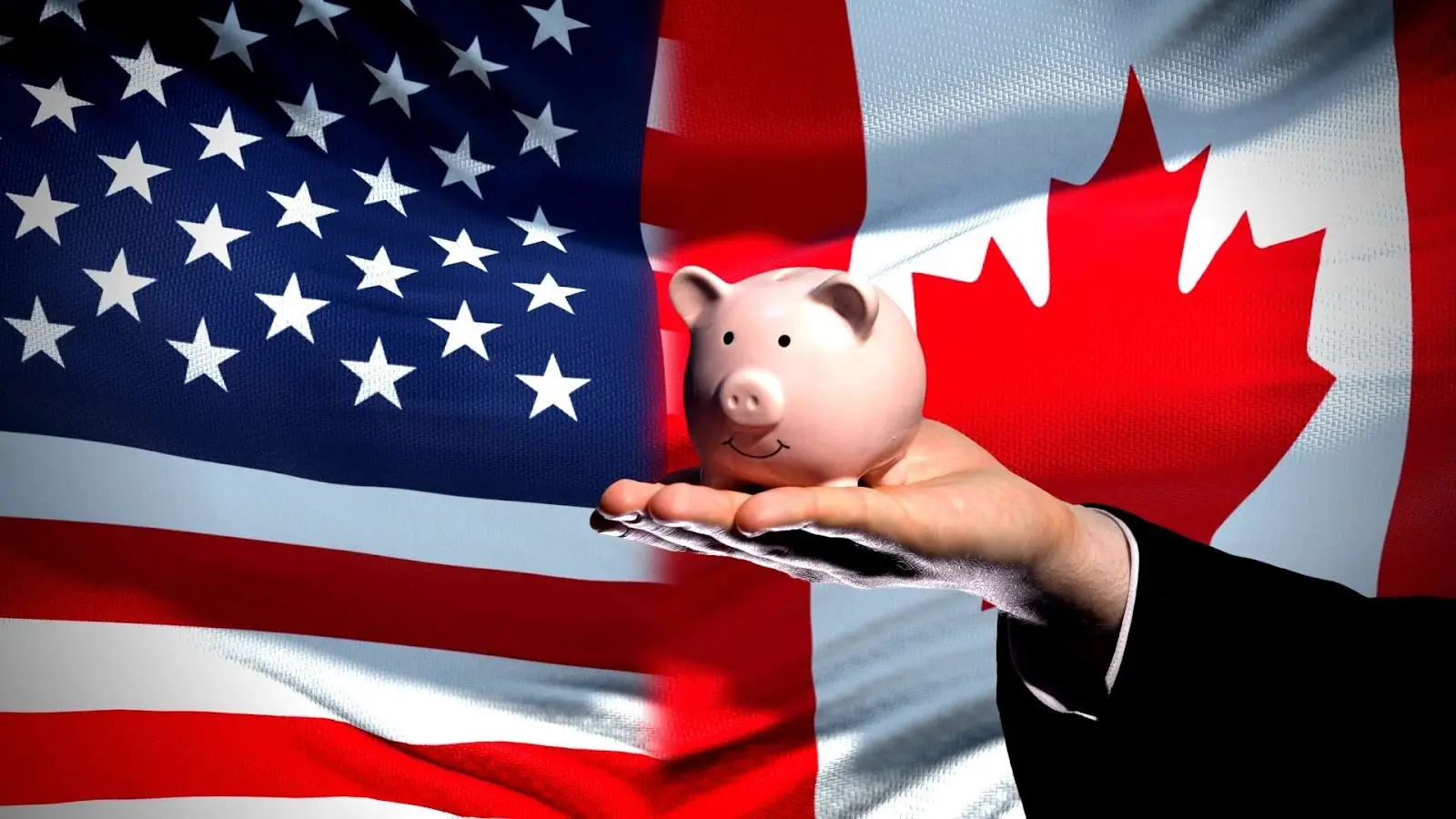Understanding cross-border withholding taxes is key if you do business or earn income under the tax treaty between the United States and Canada. The U.S.-Canada tax treaty offers major tax benefits. It can lower or even remove withholding taxes on income like dividends, interest, royalties, and pensions.
This guide breaks down how the treaty works. You’ll learn how it reduces tax burdens and how to stay compliant while making the most of these benefits.
Table of Contents
Quick Takeaways
- Withholding Tax: Cross-border income is often hit with withholding tax, but tax treaties can lower or cancel this.
- Forms to File: Use forms like W-8BEN, W-BENE or NR301 before payments to claim reduced tax rates.
- Save More: Submit the right forms on time to avoid overpaying taxes.
- Residency Check: Make sure you qualify as a resident of the country to use treaty benefits.
What is Withholding Tax Under the U.S.-Canada Tax Treaty?
Withholding tax is the tax taken straight from certain types of income, like dividends or interest, paid across borders. The U.S.-Canada tax treaty helps reduce or even remove this tax. It depends on the type of income and where the payee lives. The treaty’s goal is to prevent double taxation and ensure fair treatment for taxpayers.
→ Example: A Canadian company receiving U.S.-Canada dividend withholding tax from a U.S. business would normally face a 30% withholding tax. However, the treaty reduces it to 15%. This allows the company to keep more of its earnings.
Key Cross-Border Withholding Tax Rates Under the Treaty
The U.S.-Canada tax treaty helps cut down or even remove withholding taxes on certain types of income. Here’s a chart comparing the usual U.S. withholding tax rates with the lower rates under the treaty:
For complete details about these treaty rates and additional scenarios, check IRS Publication 597 which is about United States-Canada income tax treaty.
→ Example: A Canadian tech company earning royalties from a U.S. company would usually pay a 30% withholding tax. But by filing the right forms (like Form W-8BEN), they can bring it down to 0%, saving a lot on taxes. In my experience, this gets easily accepted without any issues as long as it’s done correctly.
How to Use the U.S.-Canada Tax Treaty to Reduce Withholding Taxes
There are some specific steps you need to take in order to lower your withholding tax with the U.S.-Canada tax treaty. Here we explain these steps:
1. Check If You Qualify for Treaty Benefits
To get lower withholding rates, you must be a tax resident of either the U.S. or Canada. According to CRA’s guidelines on determining residency status, your residency status determines your eligibility for treaty benefits. If you’re a resident of both, tie-breaker rules determine your main residency.
- Note: If you’re a tax resident in both countries, tie-breaker rules will decide your main residency. They look at where you live, work, spend the most time, have the strongest ties, and your citizenship.
2. Submit the Required Documentation
To get the lower tax rates under the treaty, you’ll need to submit a few forms. Here are the main ones:
Form W-8BEN (Individuals) or W-8BEN-E (Entities)
These forms show that you’re a non-U.S. taxpayer and help you claim the reduced tax rates.
- Pro Tip: IRS Form W-8BEN for Canadians lasts for three years, so remember to renew it. Send it to the U.S. payer before they make any payments (like on dividends and royalties) to get the lower tax rates. In my opinion, most businesses forget to do this every 3 years, so best to keep a reminder on your phone.
- Download the official Form W-8 BEN here. Also you can visit the IRS website if you are looking for more information.
Form NR301
If you’re a U.S. resident getting Canadian income, use this form to claim the treaty’s lower rates (like 15% on Canadian dividends). It helps make sure the correct tax rate is applied so you don’t get stuck with the higher U.S. rates.
- Download the official Form NR301 here. Also you can visit the CRA website if you are looking for more information.
Form 8833
Form 8833 is needed if you’re claiming special treaty benefits. It tells the IRS your treaty position.
3. Timing and Filing Process
To make sure you get the reduced tax rates, timing is key. Here’s what you need to keep in mind:
File Before Receiving Payment
In order to use tax treaties to reduce withholding rates, make sure you submit the forms before you get paid. Filing late means the higher withholding tax will apply. Plan ahead to ensure the lower rates take effect.
Documentation Updates
Forms like W-8BEN are valid for three years. Be sure to update them regularly to keep the reduced withholding tax.
Case Study: Missing Tax Treaty Filing Results in High Withholding
- The Issue: An investor lost $10,000 because they filed their tax forms late. This triggered a 25% tax on Canadian dividends instead of the lower 15% treaty rate.
- The Solution: I filed Form NR301 and W-8BEN before the investor received the dividends. I told the client to make sure to keep the forms updated, renewing W-8BEN every three years so the investor could get the lower tax rates.
- The Outcome: By filing on time, the investor saved 10% on withholding tax. Regular updates kept the lower rates in place, preventing any unnecessary tax losses.
Common Scenarios and How to Claim U.S.-Canada Tax Treaty Benefits
These are a few situations where you can use the tax treaty to lower cross-border withholding taxes. Here’s how it works:
Scenario 1: A Canadian Consultant Working with U.S. Clients
If you’re a Canadian consultant working with a U.S. client, you can avoid the 30% withholding tax by filing Form W-8BEN. This form shows you’re a foreign taxpayer and gets you the 0% withholding tax rate. The benefits are:
- Savings on the 30% tax
- More of your payment
- Easier tax reporting
- Access to other benefits (e.g., lower taxes on royalties or fees)
Scenario 2: U.S. Investor Getting Canadian Dividends
A U.S. investor getting dividends from a Canadian company can file Form NR301. This will reduce the withholding tax from the 25% Canadian domestic rate to the 15% treaty rate. The benefits are:
- 10% tax savings and more dividend
- Lower treaty rate vs. higher Canadian rate
- Correct tax treatment with treaty benefits
- Other treaty benefits (dividends, interest, etc.)
- Read more: 7 Canada US Tax Treaty Benefits You Need to Know
U.S.-Canada Tax Withholding: Common Mistakes to Avoid
Avoiding mistakes helps you get the most out of the U.S.-Canada tax treaty and avoid extra taxes. Here are the biggest ones and how to fix them:
1. Missed Deadlines
Filing forms late can cost you. Without the right forms submitted before payment, you could face higher taxes. For example, if Canadian contractors don’t give U.S. companies Form W-8BEN, the companies have to keep 30% of the payment for taxes. That’s a lot to lose.
The fix is easy. Send your forms before you get paid. It takes time to process, so try to file them 2–3 weeks early. If you’re late, you’ll have to ask the IRS or CRA for a refund, and that can take months..
2. Using the Wrong Form
Each income type needs a specific tax form. Using the wrong one can cost you treaty benefits and push your tax rate up to 30%. For instance, filing Form NR301 for U.S. royalties will skip the 0% rate and leave you paying 30%.
Always try to match your form to your income:
- Form W-8BEN – For dividends, interest, and royalties.
- Form NR301 – For U.S. residents earning Canadian income.
- Form 8833 – To claim treaty benefits.
Double-check residency, tax ID, and income type before filing. A small mistake can cost you thousands. If unsure, ask our cross-border tax experts for help.
Case Study: Wrong Tax Form Costs $15,000
- The Issue: An investor lost $10,000 because they filed their tax forms late. This caused a 25% tax on their Canadian dividends instead of the 15% treaty rate.
- The Solution: SAL Accounting stepped in. We filed NR301 and W-8BEN before the dividends were issued. The team also renewed W-8BEN every three years to ensure the investor kept the lower rates.
- The Outcome: The investor saved 10% on withholding tax and avoided future losses by staying up to date.
3. Filling Out Forms Incorrectly
Even small mistakes—like a missing tax ID, residency status, or income type—can invalidate your form. If this happens, you could lose U.S.-Canada tax treaty benefits and face the default 30% tax rate instead of a lower one.
It’s essential to double-check everything before submitting. Make sure your name, tax ID, residency details, and income type are correct. Need help with your US tax forms? Contact our US tax accountants to ensure proper documentation and compliance.
- Pro Tip: IRS and CRA reject thousands of forms every year due to errors. Avoid the hassle—take a few extra minutes to review your details.
4. Not Keeping Proof of Residency
To qualify for the U.S.-Canada tax treaty benefits, you must prove your residency. Without proper documents, tax authorities may reject your claim and apply higher taxes.
If you’re a Canadian resident claiming treaty benefits on U.S. income, get a Tax Residency Certificate from the CRA. If you’re a U.S. resident receiving Canadian income, you’ll need proof from the IRS.
- Pro Tip: Always submit your residency certificate with your tax forms. This prevents delays and makes sure the lower tax rate applies.
5. Forgetting to Renew Forms
Forms like W-8BEN expire every three years. If you forget to renew, the withholding agent must apply the higher tax rate by default.
It’s a good idea to set a calendar reminder to renew your forms before they expire. This keeps your tax rate low without interruptions.
- Example: A U.S. investor receiving $20,000 in Canadian dividends forgot to renew Form NR301. This mistake cost them an extra $2,000 in taxes because they were charged 25% instead of 15%.
6. Not Keeping Records
Even if you submit everything on time, failing to keep copies can be a problem later. If the IRS or CRA asks for proof, missing documents could mean paying higher taxes.
Keep a dedicated folder (digital or physical) for:
- All submitted tax forms
- Residency certificates
- Email confirmations from withholding agents
- Payment receipts
Audits happen. Keeping records makes it easy to prove your treaty benefits and avoid unnecessary taxes.
Frequently Asked Questions (FAQs)
It’s a tax taken from payments like dividends, interest, and royalties before you receive them. The U.S.-Canada tax treaty helps lower these taxes based on the type of income.
To reduce or avoid U.S. withholding tax, Canadians need to check if they qualify for treaty benefits, file the right form (W-8BEN for individuals or W-8BEN-E for businesses), prove they live in Canada for tax purposes, and submit the forms before getting paid.
The treaty lowers taxes on U.S. income for Canadians. Dividends are taxed at 15%, or 5% for certain shareholders. Interest is tax-free. Royalties are 0% for copyright-related payments and 10% for other types.
The treaty lowers withholding taxes and allows tax credits, so you don’t get taxed twice on the same income. It also sets rules on which countries can tax different types of earnings and includes special rules for pensions and social security.
This form proves you’re not a U.S. taxpayer and lets you claim treaty benefits. If you earn U.S. income, you need to file it to get lower tax rates. It expires every three years, so you’ll need to renew it.
Yes. If too much tax was taken, you can apply for a refund. For U.S. taxes, file Form 1042-S and Form 1040-NR. For Canadian taxes, use Form NR7-R to get back any extra withholding tax.
Final Thoughts
The U.S.-Canada tax treaty helps you pay less tax and avoid double taxation on cross-border income. Filing the right forms and keeping records can save you money and prevent tax issues.At SAL Accounting, we make cross-border taxes simple. Our experts help you maximize savings and stay compliant. Reach out today and book your FREE consultation!



